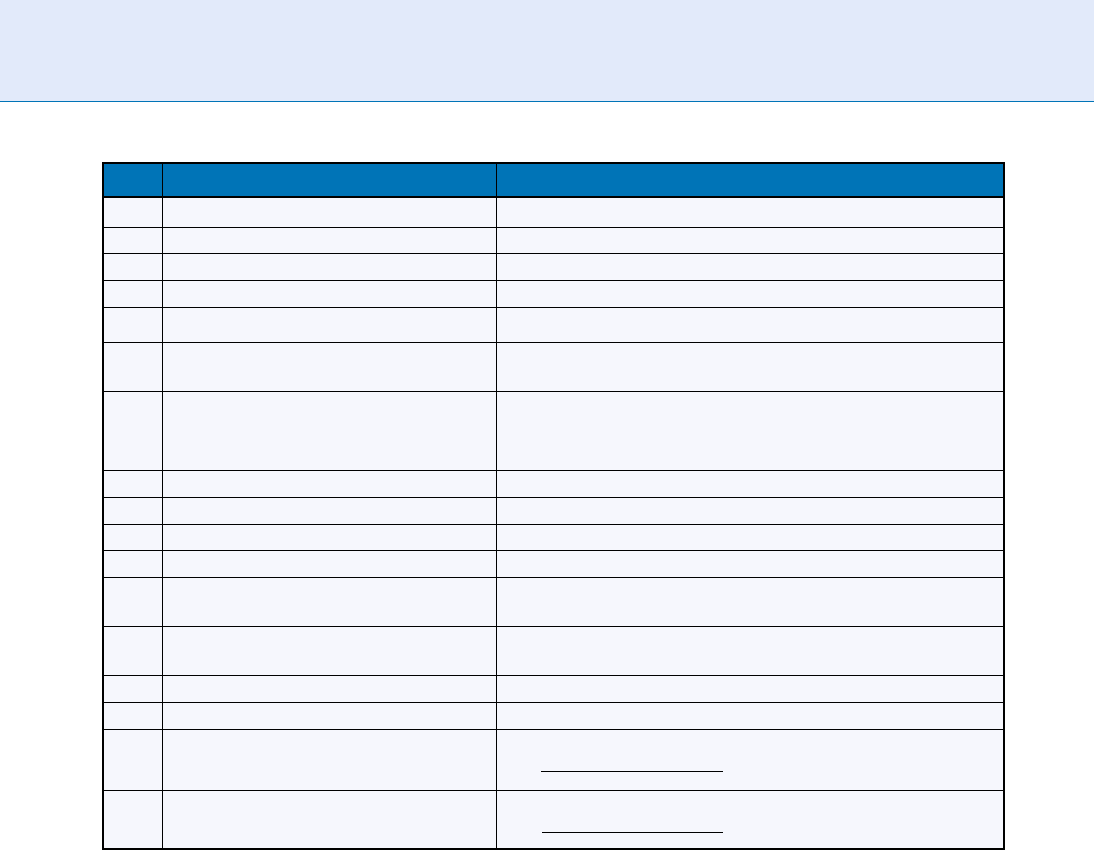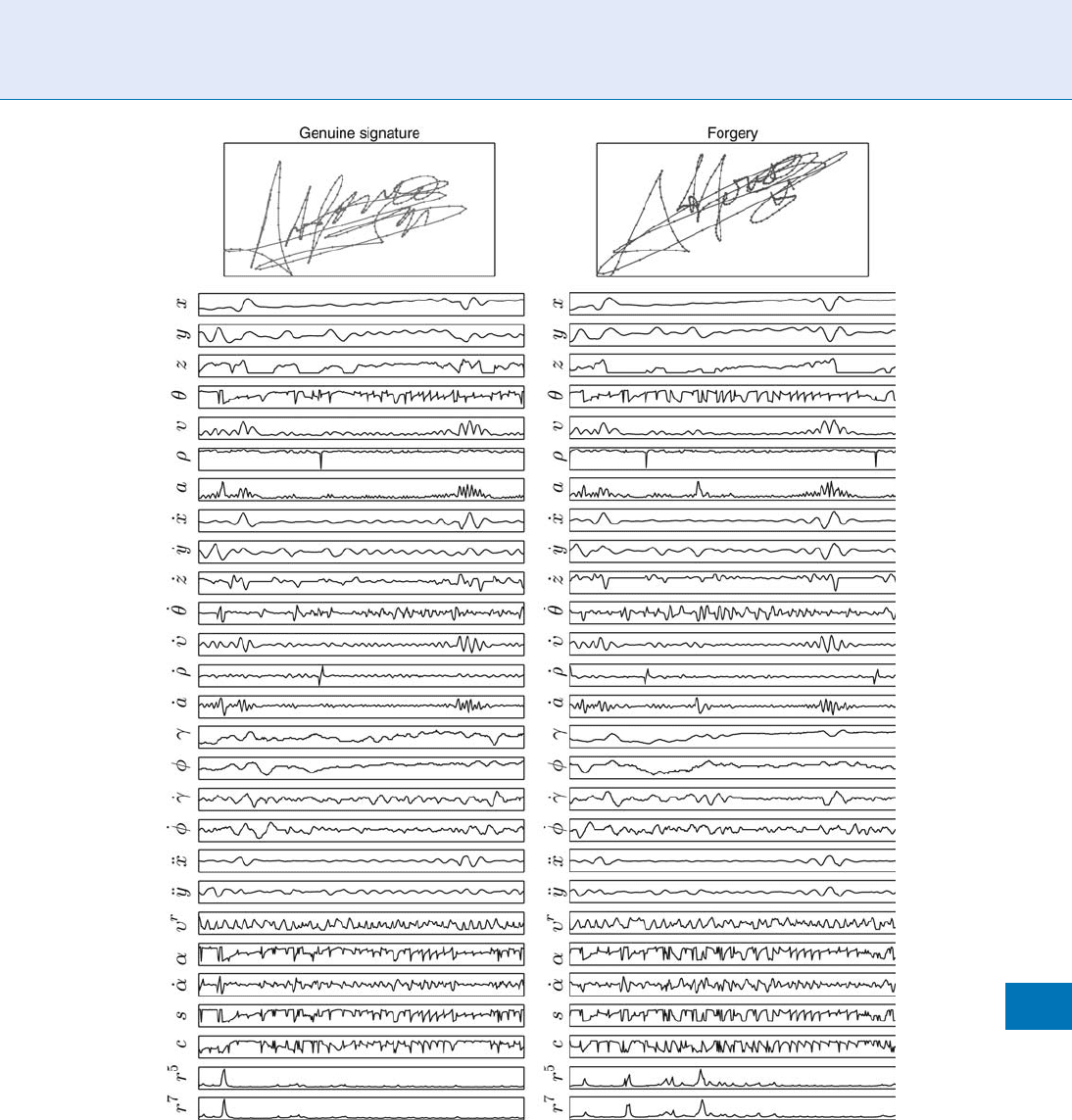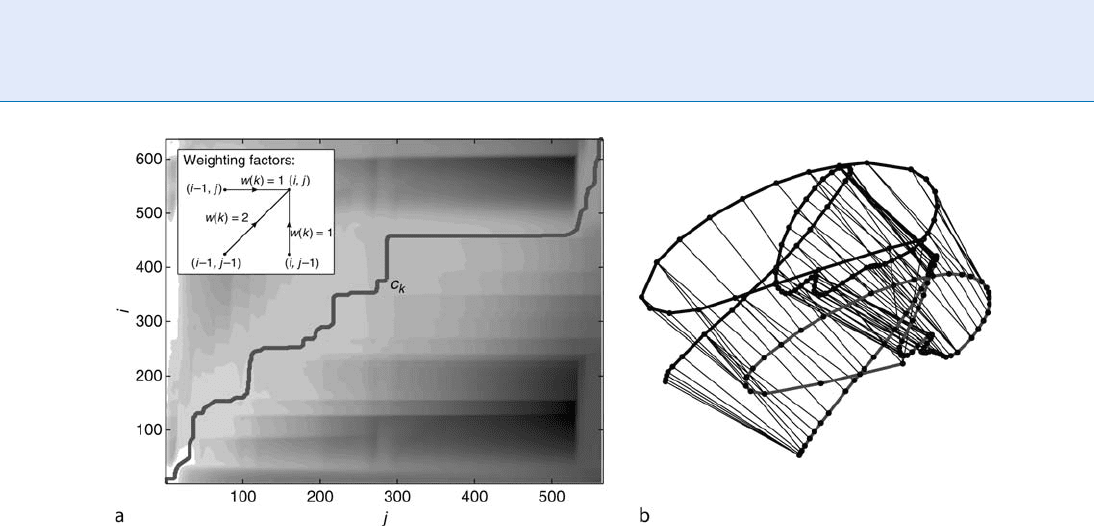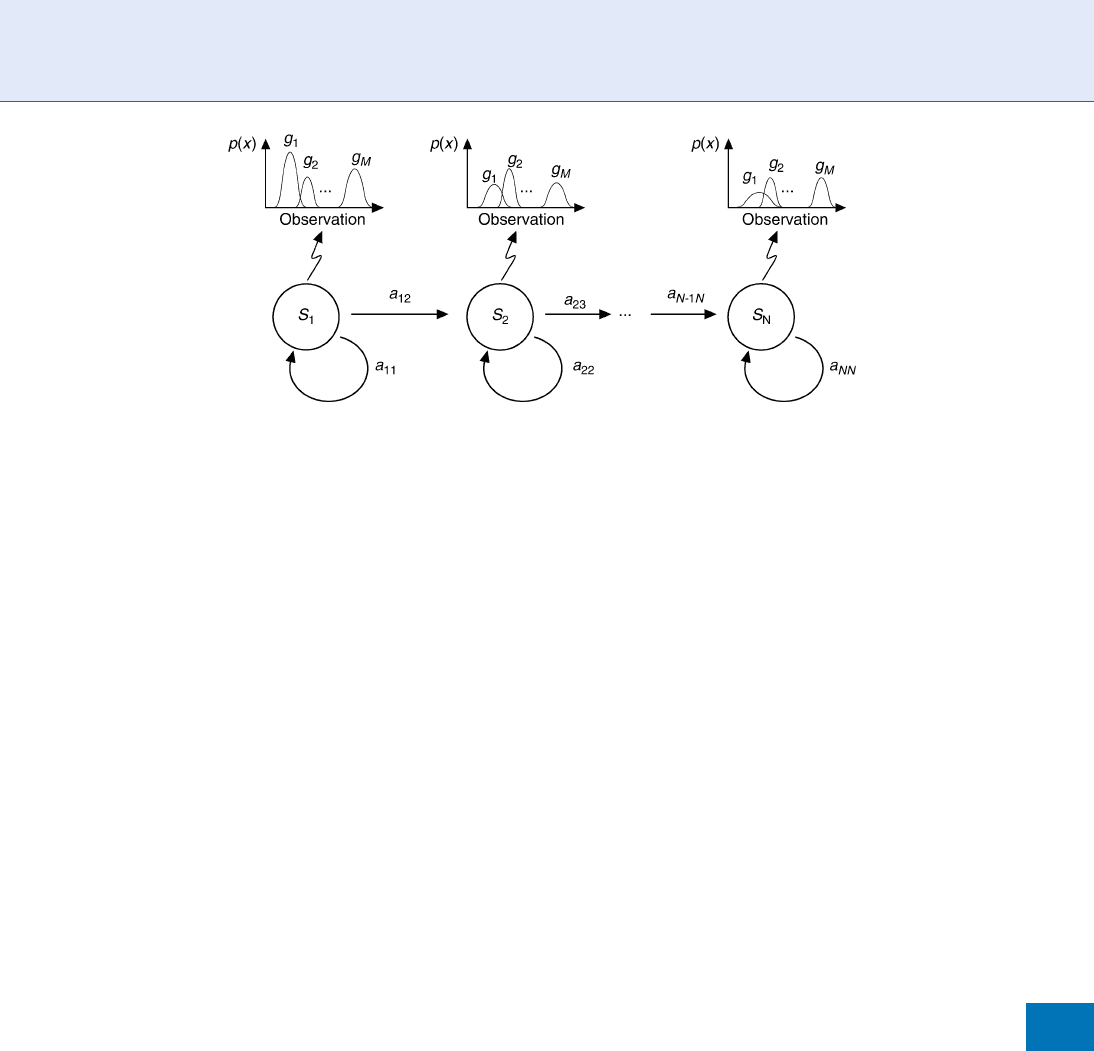Li S.Z., Jain A.K. (eds.) Encyclopedia of Biometrics
Подождите немного. Документ загружается.


Off-line signature features
Off-line signature verification systems usually rely
on image processing and shape recognition techni-
ques to extract features. As a consequence, additional
preprocessing steps such as image segme ntation and
binarization must be carried out. Features are
extracted from gray-scale images, binarized images,
or skeletonized images, among other possibilities.
The proposed feature sets in the literature are nota-
bly heterogeneous, specially when compared with the
case of on-line verification systems. These include,
among others, the usage of image transforms (e.g.,
Hadamard), morphological operators, structural
representations,
▶ graphometr ic features [14], direc-
tional histograms, and geometric features. Readers are
referred to [15] for an exhaustive listing of off-line
signature features.
Related Entries
▶ Feature Extraction
▶ Off-line Signature Verification
▶ On-line Signature Verification
▶ Signature Matching
▶ Signature Recognition
References
1. Plamondon, R., Lorette, G.: Automatic signature verification
and writer identification: the state of the art. Pattern Recogn.
22(2), 107–131 (1989)
2. Lei, H., Govindaraju, V.: A comparative study on the consistency
of features in on-line signature verification. Pattern Recogn. Lett.
26(15), 2483–2489 (2005)
Signature Features. Table 2 Extended set of local features. The upper dot notation (e.g., x
˙
n
) indicates time derivative
# Feature Description
1 x-coordinate x
n
2 y-coordinate y
n
3 Pen-pressure z
n
4 Path-tangent angle y
n
¼arctan(y
˙
n
∕ x
˙
n
)
5 Path velocity magnitude
u
n
¼
ffiffiffiffiffiffiffiffiffiffiffiffiffiffiffi
_
y
n
þ
_
x
n
p
6 Log curvature radius r
n
¼log(1 ∕ k
n
)¼log(υ
n
∕
_
y
n
), where k
n
is the curvature of the
position trajectory
7 Total acceleration magnitude
a
n
¼
ffiffiffiffiffiffiffiffiffiffiffiffiffiffi
t
2
n
þ c
2
n
p
¼
ffiffiffiffiffiffiffiffiffiffiffiffiffiffiffiffiffiffiffi
_
u
2
n
þ u
2
n
y
2
n
q
, where t
n
and c
n
are respectively the
tangential and centripetal acceleration components of the pen
motion
8 Pen azimuth g
n
9 Pen altitude f
n
10–18 First-order derivative of features 1–9 x
˙
n
,y
˙
n
,z
˙
n
,
_
y
n
,
_
u
n
,
_
r
n
,a
˙
n
,
_
g
n
,
_
f
n
19–27 Second-order derivative of features 1–9
€
x
n
,
€
y
n
,
€
z
n
,
€
y
n
,
€
u
n
,
€
r
n
,
€
a
n
,
€
g
n
,
€
f
n
28 Ratio of the minimum over the maximum
speed over a window of 5 samples
υ
n
r
¼min {υ
n4
,...,υ
n
} ∕max {υ
n4
,...,υ
n
}
29–30 Angle of consecutive samples and first
order difference
a
n
¼arctan(y
n
y
n1
∕x
n
x
n1
)
_
a
n
31 Sine s
n
¼sin(a
n
)
32 Cosine c
n
¼cos(a
n
)
33 Stroke length to width ratio over a window
of 5 samples
r
5
n
¼
P
k¼n
k¼n4
ffiffiffiffiffiffiffiffiffiffiffiffiffiffiffiffiffiffiffiffiffiffiffiffiffiffiffiffiffiffiffiffiffiffiffi
ðx
k
x
k1
Þ
2
þðy
k
y
k1
Þ
2
p
max x
n4
;:::;x
n
fgmin x
n4
;:::;x
n
fg
34 Stroke length to width ratio over a window
of 7 samples
r
7
n
¼
P
k¼n
k¼n6
ffiffiffiffiffiffiffiffiffiffiffiffiffiffiffiffiffiffiffiffiffiffiffiffiffiffiffiffiffiffiffiffiffiffiffi
ðx
k
x
k1
Þ
2
þðy
k
y
k1
Þ
2
p
max x
n6
;:::;x
n
fgmin x
n6
;:::;x
n
fg
1190
S
Signature Features

3. Richiardi, J., Ketabdar, H., Drygajlo, A.: Local and global feature
selection for on-line signature verification. In: Proceedings of
IAPR eighth International Conference on Document Analysis
and Recognition, ICDAR, Seoul, Korea (2005)
4. Kholmatov, A., Yanikoglu, B.: Identity authentication using im-
proved online signature verification method. Pattern Recogn.
Lett. 26(15), 2400–2408 (2005)
5. Fi errez, J., Ramos-Castro, D., Ortega-Garcia, J., Gonzalez-
Rodriguez, J.: HMM-based on-line signature verification: feature
extraction and signature modeling. Pattern Recogn. Lett. 28(16),
2325–2334 (2007)
6. Fierrez-Aguilar, J., Nanni, L., Lopez-Penalba, J., Ortega-Garcia, J.,
Maltoni, D.: An on-line signature verification system based on
fusion of local and global information. In: Proceedings of IAPR
Signature Features. Figure 3 Examples of functions from the 27-feature set presented in Table 2 for a genuine signature
(left) and a forgery (right) of a particular subject.
Signature Features
S
1191
S

International Conference on Audio- and Video-Based Biometric
P erson Authentication, AVBPA, Springer LNCS-3546, pp. 523–532
(2005)
7. Jain, A.K., Zongker, D.: Feature selection: evaluation, applica-
tion, and small sample performance. IEEE Trans. Pattern Anal.
Mach. Intell. 19(2), 153–158 (1997)
8. Nelson, W., Turin, W., Hastie, T.: Statistical methods for on-line
signature verification. Int. J. Pattern Recogn. Artif. Intell. 8(3),
749–770 (1994)
9. Lee, L.L., Berger, T., Aviczer, E.: Reliable on-line human signa-
ture verification systems. IEEE Trans. Pattern Anal. Mach. Intell.
18(6), 643–647 (1996)
10. Dolfing, J.G.A., Aarts, E.H.L., van Oosterhout, J.J.G.M.: On-line
signature verification with Hidden Markov Models. In: Proceed-
ings of the International Conference on Pattern Recognition,
IEEE Press, pp. 1309–1312 (1998)
11. Van, B.L., Garcia-Salicetti, S., Dorizzi, B.: On using the Viterbi
path along with HMM likelihood information for online signa-
ture verification. IEEE Trans. Syst. Man Cybern. B 37(5),
1237–1247 (2007)
12. Muramatsu, D., Matsumoto, T.: Effectiveness of pen pressure,
azimuth, and altitude features for online signature verification.
In: Proceedings of IAPR International Conference on
Biometrics, ICB, Springer LNCS 4642 (2007)
13. Martinez-Diaz,M.,Fierrez,J.,Galbally,J.,Ortega-Garcia,J.:Towards
mobile authentication using dynamic signature verification: use-
ful features and performance evaluation. In: Proceedings Interna-
tional Conference on Pattern Recognition, ICPR, pp. 1–6 (2008)
14. Sabourin, R.: In: Off-line signature verification: recent advances
and perspectives. Lect. Notes Comput. Sci. 1339 84–98 (1997)
15. Impedovo, D., Pirlo, G.: Automatic signature verification: The
state of the art. IEEE Trans. Syst. Man Cybern. C Appl. Rev.
38(5), 609–635 (2008)
Signature Matching
MARCOS MARTINEZ-DIAZ
1
,JULIAN FIERREZ
1
,
S
EIICHIRO HANGAI
2
1
Biometric Recognition Group - ATVS, Escuela
Politecnica Superior, Universidad Autonoma de
Madrid, Madrid, Spain
2
Department of Electrical Engine ering Tokyo
University of Science, Japan
Synonyms
Signature similarit y computation
Definition
The objective of signature matching techniques is to
compute the similarity between a given signature and a
signature model or reference signature set. Several pat-
tern recognition techniques have been proposed as
matching algorithms for signature recognition. In on-
line signature verification systems, signature matching
algorithms have followed two main approaches. Fea-
ture-based algorithms usually compute the similarity
among multidimensional feature vectors extracted
from the signature data w ith statistical classification
techniques. On the other hand, function-based algo-
rithms perform matching by computing the distance
among time-sequences extracted from the signa-
ture data with technique such as Hidden Markov Mod-
els and Dynamic Time Warping. Off-line signature
matching has followed many different approaches,
most of which are related to image processing and
shape recognition.
This essay focuses on on-l ine signature matching,
although off-line signature matching algorithms are
briefly outlined.
Introduction
As in other biometric modalities, signature matching
techniques vary depending on the nature of the features
that are extracted from the signature data. In feature-
based systems (also known as global), each signature
is represented as a multidimensional feature vector,
while in function-based systems (also known as local)
signatures are represented by multidimensional time
sequences. Signature matching algorithms also depend
on the enrollment phase. Model-based systems estimate
a statistical model for each user from the training
signature set. On the other hand, in reference-based
systems the features extracted from the set of training
signatures are stored as a set of template signatures.
Consequently, given an input signature, in model-
based systems the matching is performed against a
statistical model, while in reference-based systems the
input signature is compared with all the signatures
available in the
▶ reference set.
Feature-Based Systems
Feature-based systems usually employ classical pattern
classification techniques. In refere nce-based systems, the
▶ matching score is commonly obtained by using a dis-
tance measure between the feature vectors of input and
template signatures [1, 2], or a trained classifier. Distance
1192
S
Signature Matching

measures used for signature matching include Eucli
dean, weighted Euclidean, and Mahalanobis distance. In
model-based systems, trained classifiers are emplo yed,
including approaches such as Neural Networks, Gaussian
Mixtur e Models [3] or Parzen Windows [4].
Function-Based Systems
In these systems, multidimensional time sequences
extracted from the signature dynamics are used as fea-
tures. Given the similarity of this task to others related to
speaker rec ognition, the most popular approaches
in local signature verification are related to algorithms
proposed in the speech recognition community.
Among these, signature verification systems using
▶ Dynamic Time Warping (DTW) [5, 6, 7] or Hidden
Markov Models (HMM) [8, 9, 10 , 11] are the most
popular approaches in signature verification. In such
systems, the captured time functions (e.g., pen coordi-
nates, pressure, etc.) are used to model each user sig-
nature. In the following, Dynamic Time Warping and
Hidden Markov Models are outlined. An brief over-
view of other techniques is also given.
Dynamic Time Warping
▶ Dynamic Time Warping (DTW) is an application of
the Dynamic Programming principles to the problem
of matching discrete time sequences. DTW was origi-
nally proposed for speech recognition applications
[12]. The goal of DTW is to find an elastic match
among samples of a pair of sequences X and Y that
minimizes a predefined distance measure. The algo-
rithm is described as follows. Let’s define two
sequences
X ¼ x
1
; x
2
; :::; x
i
; :::; x
I
Y ¼ y
1
; y
2
; :::; y
j
; :::; y
J
ð1Þ
and a distance measure as
dði; jÞ¼ x
i
y
j
ð2Þ
between sequence samples. A warping path can be
defined as
C ¼ c
1
; c
2
; :::; c
k
; :::; c
K
ð3Þ
where each c
k
represents a correspondence (i, j) be-
tween samples of X and Y . The initi al condition of the
algorithm is set to
g
1
¼ gð1; 1Þ¼dð1; 1Þwð1Þð4Þ
where g
k
represents the accumulated distance after
k steps and w(k) is a weighting factor that must be
defined. For each iteration, g
k
is computed as
g
k
¼ g ði; jÞ¼min
c
k1
g
k1
þ dð c
k
ÞwðkÞ
ð5Þ
until the Ith and Jth sample of both sequences respec-
tively is reached. The resulting normalized distance is
DðX; Y Þ¼
g
K
P
K
k¼1
wðkÞ
ð6Þ
where ∑ w(k) compensates the effect of the length of
the sequences.
The weighting factors w(k) are defined in order to
restrict which correspondences among samples of both
sequences are allowed. In Fig. 1a, a common definition
of w(k) is depicted, and an example of a warping path
between two sequences is given. In this case, only three
transitions are allowed in the computation of g
k
. Con-
sequen tly, Eq. (5 ) becomes
g
k
¼ gði; jÞ¼min
gði; j 1Þþdði; jÞ
gði 1; j 1Þþ2dði; jÞ
gði 1; jÞþdði; jÞ
2
4
3
5
ð7Þ
which is one of the most common implementations
found in the literature. In Fig. 1b, an example of point
correspondences between two signatures is depicted to
visually show the results of the elastic alignment.
The algorithm has been further refined for signa-
ture verification by many authors [5, 7], reaching a
notable verification performance. For example, the
distance measure d(i, j) can be alternatively defined,
or other normalization techniques may be applied
to the accumulated distance g
K
among sequences.
DTW can be also applied independently for each
stroke, which may be specially well suited for oriental
signatures, since they are generally composed of seve-
ral strokes. Although the DTW algorithm has been
replaced in speech-related applications by more pow-
erful approaches such as HMMs, it remains as a highly
effective tool for signature verification as it is best
suited for small amounts of training data, which is
the common case in signature verification.
Hidden Markov Models
Hidden Markov Models (HMM) have been widely
used for speech recognition applications [13] as well
Signature Matching
S
1193
S

as in many handwriting recognition applications.
Several approaches using HMMs for dynamic signa-
ture verification have been proposed in the last years
[8, 9, 10, 11]. An HMM represents a double stochas-
tic process, governed by an underlying Markov
chain, with a finite number of states and a random
function set that generate symbols or observations
each of which is associated with one state [11].
Observations in each state are modeled with GMMs
in most speech and handwriting recognition applica-
tions. In fact, GMMs can be considered a single-state
HMM and have also been successfully used for signa-
ture verification [14]. Given a seque nce of multi-
dimensional vectors of observations O defined as
O ¼ o
1
; o
2
; ...; o
N
;
corresponding to a given signature, the goal of HMM-
based signature matching is to find the probability that
this sequence has been produced by a Hidden Markov
Model M
PðOjMÞ;
where M is the signature model computed during
enrollment.
The basic structure of an HMM using GMMs to
model observations is defined by the following elements:
Number of hidden states N.
Number of Gaussian mixtures per state M.
Probability transition matrix A ¼ {a
ij
}, which con-
tains the probabilities of jumping from one state to
another or staying on the same state.
In Fig. 2, an example of a possible HMM con-
figuration is shown. Hidden Markov Models are
usually trained in two steps using the enrollment
signatures. First, state transition probabilities and
observation statistical models are estimated using
a Maximum Likelihood algorithm. After this, a re-
estimation step is carried out using the Baum-Welch
algorithm. The likelihood between a trained HMM
and an input sequence (i.e., the matching score) is
computed by using the Viterbi algorithm. In [10],
the Viterbi path (that is, the most probable state tran-
sition sequence) is also used as a similarity measure.
A detailed description of Hidden Markov Models is
given in [13].
Within HMM-based dynamic signature verifica-
tion, the existing approaches can be divided in regional
and local. In regional approaches, the extracted time
Signature Matching. Figure 1 (a) Optimal warping path between two sequences obtained with DTW. Point-to-point
distances are represented with different shades of gray, lighter shades representing shorter distances and darker
shades representing longer distances. (b) Example of point-to-point correspondences between two genuine
signatures obtained using DTW.
1194
S
Signature Matching

sequences are further segmented and converted into
a sequence of feature vectors or observations, each
one representing regional properties of the signature
signal [9, 11]. Some examples of segmentation bound-
aries are null vertical velocity points [9] or changes in
the quantized trajectory direction [11]. On the other
hand, local approaches directly use the time functions
as obse rvation sequences for the signature modeling
[8, 10, 14].
Finding a reliable and robust model struc ture for
dynamic signature verification is not a trivial task.
While too simple HMMs may not allow to model
properly the user signatures, too complex models
may not be able to model future realizations due to
overfitting. On the other hand, as simple models have
less parameters to be estimated, their estimation may
be more robust than for complex models. Two main
parameters are commonly considered while selecting
an optimal mode l structure: the number of states and
the number of Gaussian mixtures per state [8]. Some
approaches consider a user-specific number of states
[10], proportional to the average signature duration or
a user-specific number of mixtures [14]. Most of the
proposed systems consider a left-ro-right configura-
tion without skips between states, also known as
Bakis topolog y (see Fig. 2).
Other Techniques
More examples of signature matching techniques in-
clude Neural Networks, in particular Bayesian,
multilayer, time-delay Neural Networks and radial-
basis functions among others have been applied for
signature matching. Other examples include Structural
approaches, which model signatures as a sequence, tree
or graph of symbols. Support Vector Machines have
also been applied for signature matc hing. The reader is
referred to [15] for an exhaustive list of references
related to these approaches.
Fusion of the feature- and function-based
approaches has been reported to provide better perfor-
mance than the individual systems [4].
Off-line Signature Matching
The proposed approaches for off-li ne signature match-
ing are notably heterogeneous compared to on-line
signature verification. These are mostly related to
image and shape recognition techniques and classical
statistical pattern recognition algorithms. They include
Neural Networks, Hidden Markov Models, Support
Vector Machines and distance-based classifiers among
others. A summary of off-line signature matching tech-
niques can be found in [15].
Related Entries
▶ Off-line Signature Verification
▶ On-line Signature Verification
▶ Signature Features
▶ Signature Recognition
Signature Matching. Figure 2 Graphical representation of a left-to-right N-state HMM, with M-component GMMs
representing observations and no skips between states.
Signature Matching
S
1195
S

References
1. Nelson, W., Turin, W., Hastie, T.: Statistical methods for on-line
signature verification. Int. J. Pattern Recogn. Artif. Intell. 8(3),
749–770 (1994)
2. Lee, L.L., Berger, T., Aviczer, E.: Reliable on-line human signa-
ture verification systems. IEEE Trans. Pattern Anal. Mach. Intell.
18(6), 643–647 (1996)
3. Martinez-Diaz, M., Fierrez, J., Ortega-Garcia, J.: Universal Back-
ground Models for dynamic signature verification. In: Proceed-
ings IEEE Conference on Biometrics: Theory, Applications and
Systems, BTAS, pp. 1–6 (2007)
4. Fierrez-Aguilar, J., Nanni, L., Lopez-Penalba, J., Ortega-Garcia, J.,
Maltoni, D.: An on-line signature verification system based
on fusion of local and global information. In: Proceedings
of IAPR International Conference on Audio- and Video-Based
Biometric Person Authentication, AVBPA, Springer LNCS-3546,
pp. 523–532 (2005)
5. Sato, Y., Kogure, K.: Online signature verification based on
shape, motion and writing pressure. In: Proceedings of sixth
International Conference on Pattern Recognition, pp. 823–826
(1982)
6. Martens, R., Claesen, L.: Dynamic programming optimisation
for on-line signature verification. In: Proceedings fourth Inter-
national Conference on Document Analysis and Recognition,
ICDAR, vol. 2, pp. 653–656 (1997)
7. Kholmatov, A., Yanikoglu, B.: Identity authentication using im-
proved online signature verification method. Pattern Recogn.
Lett. 26(15), 2400–2408 (2005)
8. Fierrez, J., Ramos-Castro, D., Ortega-Garcia, J., Gonzalez-
Rodriguez, J.: HMM-based on-line signature verification:
feature extraction and signature modeling. Pattern Recogn.
Lett. 28(16), 2325–2334 (2007)
9. Dolfing, J.G.A., Aarts, E.H.L., van Oosterhout, J.J.G.M.: On-line
signature verification with Hidden Markov Models. In: Proceed-
ings of the International Conference on Pattern Recognition,
ICPR, pp. 1309–1312. IEEE CS Press (1998)
10. Van, B.L., Garcia-Salicetti, S., Dorizzi, B.: On using the Viterbi
path along with HMM likelihood information for online signa-
ture verification. IEEE Trans. Syst. Man Cybern. B 37(5),
1237–1247 (2007)
11. Yang, L., Widjaja, B.K., Prasad, R.: Application of Hidden
Markov Models for signature verification. Pattern Recogn.
28(2), 161–170 (1995)
12. Sakoe, H., Chiba, S.: Dynamic programming algorithm optimi-
zation for spoken word recognition. IEEE Trans. Acoust. 26,
43–49 (1978)
13. Rabiner, L.R.: A tutorial on Hidden Markov Models and selected
applications in speech recognition. Proceedings of the IEEE
77(2), 257–286 (1989)
14. Richiardi, J., Drygajlo, A.: Gaussian Mixture Models for
on-line signature verification. In: Proceedings of ACM SIGMM
Workshop on Biometric Methods and Applications, WBMA.
pp. 115–122 (2003)
15. Impedovo, D., Pirlo, G.: Automatic signature verification: The
state of the art. IEEE Trans. Syst. Man. Cybern. C Appl. Rev.
38(5), 609–635 (2008)
Signature Recognition
OLAF HENNIGER
1
,DAIGO MURAMATSU
2
,
T
AKASHI MATSUMOTO
3
,ISAO YOSHIMURA
4
,
M
ITSU YOSHIMURA
5
1
Fraunhofer Institute for Secure Information
Technology, Darmstadt, Germany
2
Seikei University, Musashino-shi, Tokyo, Japan
3
Waseda University, Shinjuku-ku, Tokyo, Japan
4
Tokyo University of Science, Shinjuku-ku, Tokyo,
Japan
5
Ritsumeikan University, Sakyo-ku, Kyoto, Japan
Synonyms
Handwritten signature recognition; signature/sign
recognition
Definition
A si gnature is a handwritten representation of name of
a person. Writing a signature is the established method
for authentication and for expressing deliberate deci-
sions of the signer in many areas of life, such as banking
or the conclusion of legal contracts. A related concept is
a handwritten personal sign depicting something else
than a person’s name. As compared to text-independent
writer recognition methods, signature/sign recognition
goes with shorter handwriting probes, but requires to
write the same name or personal sign every time. Hand-
written signatures and personal signs belong to the
behavioral biometric characteristics as the person must
become active for signing.
Regarding the automated recognition by means of
handwritten signatures, there is a distinction between
on-line and off-line signature recognition. On-line sig-
nature data are captured using digitizing pen tablets,
pen displays, touch screens, or speci al pens and include
information about the pen movement over time (at
least the coordinates of the pen tip and possibly also the
pen-tip pressure or pen orientation angles over time).
In this way, on-line signature data represent the way a
signature is written, which is also referred to as signa-
ture dynamics. By contrast, off-line (or static) signa-
tures are captured as grey-scale images using devices
such as image scanners and lack temporal information.
1196
S
Signature Recognition

Overview
Off-line and On-line Signatures
A number of features that are suitable for automated
comparison can be extracted from handwritten signa-
tures. The features depend on the ty pe of data captured
and the chosen comparison method. Handwriting data
can be classified into
on-line data captured during the writing process
using devices such as digitizing tablets, Tablet PC’s,
or special pens
off-line data captured from paper after the writing
process using devices such as image scanners or
cameras
Dynamic information, like
▶ stroke order, writing
▶ speed, and ▶ pen pressure, is available in on-line
data, whereas only static information, like the shapes
of handwritten characters, is available in off-line data.
There is a multitude of methods for comparing hand-
written signatures, see under on-line signatures and
off-line signatures below.
Applications
Handwritten signatures are generally used for verifica-
tion (confirming a claimed identity through one-to-
one comparisons of biometric features), but rarely for
identification (finding identifiers attributable to a per-
son through one-to-many search among biometric
features in a large database) [1]. Handwritten signa-
tures have been used for a long time for authentication
purposes in many applications, such as credit cards,
banking transactions, agreements, and legal documents.
Off-line signature serve as a unique means to verify the
authenticity of a person through past records, such as
signatures on traveler’s cheques.
Strengths and Weaknesses
In order that handwritten signatures are useable for
recognizing persons, genuine signatures (i.e. signatures
written by the persons themselves whose names they
represent) need to be sufficiently repeatable over time
with respect to the comparison criteria, and forgeries
(i.e. signatures not written by the persons themselves
whose names they represent) need to be distinguish-
able from the genuine signatures by means of the
comparison criteria [2]. As for some persons the hand-
written signatures may vary considerably from signa-
ture to signature, the permanence of handwritten
signatures is considered lower than that of many phys-
iological biometric characteristics. As forgers can learn
with some effort how to imitate the signatures of their
victims, also the distinctiveness of handwritten signa-
tures is lower than that of many physiological biomet-
ric characteristics. However, forging the signature
dynamics is considerably harder than just forging the
signature shape [3, 4] because information about the
signature dynamics is less easily accessible to potential
forgers than information about the signature shape.
The strengths of handw ritten signatures compared
to other biometric characteristics lie in a high level and
wide spread of user acceptance and in the fact that
handwritten signatures are regarded as an evidence of
a deliberate decision on the part of the signer. Further-
more, people can modify their signatures in case of
successful forgeries. By contrast, physiological biomet-
ric characteristics such as fingerprints or irises cannot
be modified.
Performance Testing of Signature
Verification Systems
Types of Testing
Users may obtain feedback (accepted or rejected) from
the signature verification system, which then influences
their subsequent input signatures. Genuine users will
become accustomed to the system, and forgers w ill use
this feedback to improve their signatures. Thus, in
order to determine the performance in practice, sce-
nario tests and operational tests (where users input
signatures to a prototype or operational verification
system) are preferable. Such tests, however, are expen-
sive and time consuming, and it is extremely difficult to
conduct tests on a large population. Moreover, since
the decision threshold of the system must be fixed, we
cannot evaluate the overall performance of the system.
Tests on databases can be easily conducted and a
large population can be tested. Moreover, such tests
can be conducted under the same conditions whenever
needed, and we can compare the different sy stems and
evaluate the overall performance of a system by assum-
ing different decision thresholds. Thus, technology
Signature Recognition
S
1197
S

tests using pre-existing or specially collected databases
of genuine signatures and forgeries are useful to develop
practical systems.
Neither scenario nor technology tests, by itself, are
sufficient to evaluate the actual performance. There-
fore, both tests should be conducted to estimate the
performance of the system in practice.
Evaluation Protocol
The performance of a signature recognition system
depends on the writing conditions and instruments,
skill of writers, required level of similarity for accep-
tance or rejection, and precision and reliability of tem-
plates. The performance of a system is also highly
dependent on the quality of the sample images to be
verified. Thus, the design and configuration of the test
should be carefully considered when performing eval-
uation experiments:
The number of training signatures input during
enrollment: 3–20 training signatures, or more,
have generally been used in previous studies. For
instance, in [5], five signatures were used for
training.
Selection method of training signatures from a da-
tabase: Some researchers select training signatures
randomly from genuine signatures, and some
researchers select them from the first several signa-
tures of the first session. Considering the actual
situation, it is reasonable to select the first several
signatures for training. In [ 5], genuine signatures
were collected from two sessions, and training sig-
natures were randomly selected from the first ses-
sion. This process was repeated ten times.
Types of forgeries available for training: In general,
skilled forgeries are not available, and thus, genuine
signatures of other peop le are used as random for-
geries. In [5], skilled forgeries were not supplied for
training.
Parameters of decision threshold: Some researchers
determine the parameters for the decision thresh-
old using all of the data, including test data, and
other researchers determine them using only train-
ing data. In the former case, the evaluated result is
termed ‘‘ideal’’ [6].
Forgery Data
The measured false match rate, which is useful for
predicting the forgery resistance of a signature
recognition system, depends on the degree of effort
with which signatures of other persons are tried to be
imitated. Different types of signature forgeries requir-
ing different skill levels can be distinguished, such as:
Random forgery (also accidental forgery or zero-
effort impostor attempt) where an impostor with-
out knowledge of the genuine signature presents
any handwriting
Simple forgery where an impostor with knowledge
of the genuine signature mimics it from memory
without practice
Simulated forger y where an impostor traces a genu-
ine signature without prior practice
Skilled forgery where an impostor mimics the gen-
uine signature after practicing
The quality of skilled forgeries depends on the capa-
bility of the forgers, what kind of information they
know, how they practice, and how motivated they are.
False match rates measured based on zero-effort
impostor attempts, where impostors submit their
own biometric characteristics while claiming to be
someone else, are meaningful for biometric systems
based on physiological characteristics, but are of less
relevance for predicting the forgery resistance of signa-
ture recognition systems where impostors can easily
take action to influence the outcome of recognition
attempts in their favor. A skilled forgery is the most
difficult to distinguish from a gen uine signature.
Therefore, for a reliable prediction of the forgery resis-
tance of signature recognition systems, the measure-
ment of false match rates should be based on skilled
forgeries. In [5], random forgeries and skilled forgeries
were separately used for evaluation.
Signature Databases
For many years, there were no publicly available data-
bases. Therefore, each researcher needed to generate
his or her own private databases and evaluate algo-
rithms using them. These databases were not shared
with other researchers, and thus, it was difficult to
compare the performance of algorithms under the
same conditions. This is due to the difficulty in
providing forgeries that possess a sufficient level of
quality. Forgers, imposters, and seasoned document
examiners refuse to or are reluctant to furnish evidence
of skillful forgery because such evidence is considered
valuable private property.
1198
S
Signature Recognition

In the meantime, several on-line signature data-
bases have been developed and made available by sev-
eral research groups. For example, databases collected
by Munich and Perona [7], MCYT [8], BIOMET [9],
SVC2004 [5], and MYIDEA [10] are available. These
databases contain genuine signatures and skilled for-
geries of varying quality. Forgeries in some databases
were written by forgers who knew dynamic informa-
tion about genuine signatures, whereas forgeries in
other databases were written by forgers who knew
only shape information about genuine signatures.
Practical experience with respect to forgeries on bank
cheques may be accumulated in places such as Brazil, or
in criminal science studies in police institutions [11].
Databases are useful to compare different signature
recognition algorithms. However, each database is col-
lected based on a different policy, and they inevitably
differ in nature. Thus, evaluation using only a database
is not sufficient to determine the overall perf ormance.
Off-line Signatures
Introduction
Off-line signature recognition is the recognition of
handwritten signatures based on a two-dimensional
gray image obtained by an item of equipment such as
a scanner, an optical reader, or a digitizer. Figure 1
depicts an example of an off-line signature.
Since the invention of writing in human society,
the signature on a document (or picture, including
monochrome brush painting) has been the most com-
mon means of authenticating the writer (or painter)
of the document (or picture). Not only leaders but
also persons accorded with responsibility in various
capacities have had to put their signatures on paper
and recognize those of the others. Thus, signature
recognition has naturally been done off-line. It is only
with the recent development of an on-line technology
for biometric recognition that the relevance of off-line
recognition has been reduced. The relative character-
istics of on-line and off-line methods of signature
recognition will be di scussed later.
The written name of the writer was originally used
as signature. In the course of the traditional use of
signatures, people started including symbols and dis-
torting them in order to increase their uniqueness and
beauty. In general, this made it impossible to recover
the writers’ names from such signatures. Further, some
signatures, like names, are merely personal signs that
help establish authenticity. In this sense, off-line signa-
ture recognition merely entails pattern recognition of
questionable images on a two-dimensional space by
referring to registered reference images, which may be
reduced to a template [3, 12, 2].
The following sections describe the basic modules
of the recognition procedure (i.e. data capture, prepro-
cessing, quality assessment, feature extraction, format-
ting, comparison, decision) for off-line signatures [13].
Basic Operation
Cutting off
In this module, a rectangular space containing the
entire image is identified, and the gray image of this
area is acquired using an appropriate item of equip-
ment such as a scanner.
Preprocessing
The size of questionable images is not always the sam e
as that of the reference images. Normalizing the size of
a questionable image is necessary in order to compare
it with templates and thereby facilitate recognition.
The background color of the sheet is not always
white. In fact, all cheques contain colored patterns for
preventing counterfeits, as shown in Fig. 2 [14]. As a
result, eliminating the effect of the background pattern
and the adjustment of gray levels is inevitable in pre-
processing. In general, the binarizing of gray levels up
to a certain threshold is preferred to obtain a steady
performance of the system .
Normalizing the angle to the baseline (if it exists)
proves to be effective in adjusting the signature
Signature Recognition. Figure 1 Off-line signature image.
Signature Recognition
S
1199
S
